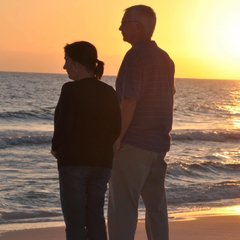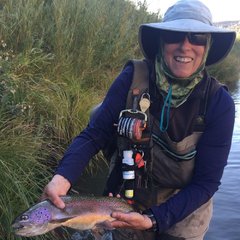Leaderboard
Popular Content
Showing content with the highest reputation on 02/17/2019 in all areas
-
In 2016, a Canadian couple traveled trans Canada in their new model x towing an Alto Safari. They rarely could use a supercharger. Usually charged at campsites. That went so well (with some days of range anxiety), that they continued on to Florida, across the US, and back to BC. Trip time was about 10 months. https://teslaxcanada.com/ It can be done, but takes some planning. And, probably not John's kind of off trail adventures.. Sherry2 points
-
I’m not sure any of that is of practical concern to most campers. Most travelers stick to paved roads and commercial campgrounds with full hookups, and $10 for charging is a ton cheaper than a tank of gas. I was probably wrong though about charge time, not because of AC use but because as the battery capacity on these trucks increase, so will the time it takes to fill them. A 270kWh battery bank would take the better part of a day to fully charge from a 240v 50a pedestal. So they will require something similar to the 480 volt Tesla Superchargers. That might be a problem for smaller independent operations but no big deal for KOA, etc. Apart from vehicle and trailer payments, fuel is by far the greatest expense for full timers, and being able to save $100+/day in travel expense is a big motivator. The demand will be there and supply will follow. Smart campground owners should be thinking about installing a few higher capacity charge points now, and advertising them as Tesla chargers until demand from campers catches up.2 points
-
You can poke your nose in the access hatch to see if a wire has come loose. Otherwise, it could be a bad switch, short in the wire, or worst case something in the unit has fried. If you’ve got a multimeter, you can check for all but the last of those ideas.2 points
-
Thanks for the welcome. I’m still trying to navigate the forum and apologize for being late in a response. I’m looking forward to learning all I can before pulling the trigger2 points
-
Great video that spells this out so that even I understand it, sorta. "Towing capacity, quite frankly, is the least important number..." https://youtu.be/qwFLOBrADBs Chris2 points
-
I wouldn't get too philosophical about the valve configuration. Normal is anything that isn't boondocking or winterization. Apart from the valves, normal doesn't usually include water coming out of the weeps, so my guess is a leak. I'd check the streetside access hatches per above, and also pull out the basement matt and check the connections under there. Yeah, 20psi is really low. My regulator is set a bit over 60.1 point
-
Check the outside shower. If nothing there sounds like a possible leak if you have not hook to city water before.1 point
-
It is always an interesting read - the considerate replies to TV capabilities. What strikes me is the number of folks that are close, perhaps - "on the bubble" with the current TV, and question, rightly so, where the chips lie.. some seem to favor ultra-lite RVing, nothing wrong there, just not me... I would think your JGC would be "OK" - try it out, get some experience, experiment with your loads, do some real world weighing - worst case, you end up getting something more capable. I've been doing some backpacking - and ultra lite resonates with my aging back and legs - but not with my TV. I was on the bubble myself, within safe ranges, but not within the comfort and no worries range I wanted. Once I went to my current TV, it was no contest. Wish you well with your journey. RB1 point
-
For one, I think that eventually EV makers will need to standardize their charging. Tesla's Superchargers are a great marketing tool for them now, but it doesn't make much sense for every manufacturer to build independent charging networks. But after running those numbers, I'm kind of surprised that RV parks aren't currently advertising themselves as EV charge stations. They're conveniently located and spaced on highways, there are always empty spots, aren't a terrible place to hang out for an hour or two, and converting/adding some 100 or 200 amp pedestals wouldn't be too much of an outlay. I think if I owned an RV park, this stuff would be occupying most of my free brain cells.1 point
-
Looking at the battery and range specs for the Rivian, you could extrapolate that a 400kWh battery pack would probably be enough to tow 600 miles (~2.2 miles per kWh and for the sake of argument a 30% loss in range for towing). That assumes no gains in motor, aerodynamic or other efficiencies. 400,000Wh/480v = 833.3 amp hours / 8 hours overnight charge time = 104.2 amps. That's reasonable from a wiring standpoint. For that matter, a 240v/200A service gives you 400,000/240/200 = 8.3 hours overnight charge time - again, perfectly reasonable. That's also reasonable from a battery/range standpoint, roughly double the current capacity. For comparison, the maximum range for a Tesla S has increased 2.4 times over the last five years. Also, I'm running these numbers assuming 8 hours on the road at 75mph. Most people only tow at 60 or 65 and if you're not barnstorming national parks like my wife and I, you might only want to be on the road around 6 hours per stint. 6 hours at 65mph is only 390 miles. Assume you want a 600 mile advertised range for an ample safety margin, which would be a 270kWh battery pack. 270,000/240/100 amp service = 11.25 hours of charge time, which is still reasonable for overnight charging, and accomplished without much outlay from RV parks. So I'm going to predict that with only a 50% increase in range we're going to see some early adopters.1 point
-
You really don’t have any overhead for a 7000 pound trailer, your GC will be maxed out unless you travel light with only a couple of people. I say try it for a while and see how it does for you. If you think it handles the weight OK but could use more grunt, for around $2K you can change both ring and pinions to a lower ratio (bigger number) to get lots more more torque. What axle ratio does it have? Some V8 GCs come with 3.07 ratio which is VERY bad for towing. My Land Cruiser has almost identical power as your trucklet but a 3.9 ratio, so it does OK. I run oversized 33” tires so I may actually change them to 4.33 to get back the lost power from that alteration. If you want to find out your your axle info, give your dealer the VIN and he can give you a printout. Unfortunately light duty SUVs have ratios designed to maximize empty cruising mpgs, which is bad for towing performance. There isn’t anything you can do if you need to carry more weight, except upgrade to a bigger vehicle. http://www.rvforum.net/SMF_forum/index.php?topic=104043.0 BTW your GC would be a perfect fit for the smaller Ollie. John Davies Spokane WA1 point
-
True, but one huge handicap is you have to park a Tesla for 40 minutes for a partial 80% charge from a Supercharger station. An hour + for a full one. Bigger battery packs in trucks will mean longer charge times. A double sided gas pump can handle two cars every five minutes, where are you going to park all these electric vehicles with trailers while they reload with electrons? If you are overnighting, and there is a connection right there, no worries. But what about in-between stops? But if the towing range is 600 miles that would probably be a moot point. If it remains at 200, it will be a problem. No more five minute gas-and-go pit stops. It will be harder to cover lots of miles in a day. Unless you can do the whole trip nonstop. I just don’t see how that will ever become an acceptable situation. Maybe it could work for small self contained van type E-RVs. Our highways and bridges are falling to pieces from neglect and the constant pounding of forty ton semis..... What we really need are cargo teleportation pads.... No more heavy commercial traffic! Highways filled with self propelled Eco-Olivers driven by all those out of work truck drivers! John Davies Spokane WA1 point
-
Nah, the Rivian owner will just fire up his little cold fusion power pack and recharge the truck in an hour. These will never be useful for real, long distance RV towing. But for very local trips, to the lake and back with a boat, or to Home Depot for building supplies they may be great. But the owner will always have severe range anxiety... because in inclement conditions or steep terrain it will be so hard to calculate. Do these have regen? If so, when you hit the red mark at the top of the Ike Gauntlet, you could u-turn and coast back to the bottom... And then trade it in on a real truck...... John Davies Spokane WA1 point
-
That is a little mind numbing but very informative. Thank you. I laughed out loud around 9:00 minutes when he started describing the trailer he wanted to buy, a 35 ft toy hauler with a 2800 POUND TONGUE WEIGHT. Holy moly. The thing about toy haulers with a big rear garage is that they must be designed to carry half a ton or more of vehicles all the way in the back while still maintaining at least 8 or 10% tongue weight for stability. When they are loaded down, the tongue weight will be reduced to that amount, hopefully. But towing a toy hauler with that rear garage empty can be very bad indeed, due to the huge tongue weight when all that rear ballast is gone. I do not understand why anyone would buy one of these monsters.... you really need a fifth wheel setup with a big dually pickup. It is insane to use a regular hitch for this thing. Sorry to drift off topic. Toy haulers make me really mad. But that is a great video. John Davies Spokane WA1 point
-
Nan, going to put my two cents in. I am a woman in my mid 60's. The past two years I towed a 1200 pound modified tear drop. About three weeks ago I took possession of my Elite. I have towed the Elite to the DMV for inspection, parked it in an RV lot after 6 inches of snow has fallen, and most recently moved it into indoor storage. The first week I had it I took it over to a church parking lot (during the day mid-week ) and practiced backing it up, pulling it around, parking it between parking lines, and took if off the Anderson Sway bar for about an hour. Once you get the confidence it is not that hard! Just be patient, take it slow, and don't be intimidated! If you have a friend that has some time and can go with you to help you during this learning curve, that will also help you get used to towing.1 point
-
I missed that thread. Did you ever try John's idea about testing it with the dinette hatch open? If not, I may try that myself when I get a chance. I suspect, however, that the airflow would go counterclockwise, around the back of the tanks, since the space under the front entrance is mostly blocked (see the photo above). That might help keep the plumbing in the rear street corner warm but wouldn't do anything for the closet corner. I think the ideal spot for the return air would be beneath the closet door, with a duct in the closet channeling it down between the hulls. Then the air would come right down over the water lines and then travel the long way around the trailer, keeping the entire space warm. Alternatively, cutting the duct in that location would accomplish a similar airflow, and with warmer air. It would also give the benefit of positive pressure between the hulls, which would discourage the furnace from drawing outside air in through the weeps, as it surely does now. You lose the bath vent, of course, and it would be more difficult to regulate the air to the cabin. Details. It also seems like a ton of heat is lost into the back curbside corner from the furnace and plenum, both of which are completely uninsulated. That keeps the water pump area toasty of course, but it seems like some of that heat would be more useful elsewhere. It might be worth adding some insulation around the furnace as an experiment. In short, I think that there are some definite avenues for finding more efficiency in the system - it's just up to one of us owners to find the time and energy to put towards it.1 point
-
That is a good idea Oliver should check out! Put the return as far from the furnace as is practical. On the Elite I, the return is on the front dinette seat, basically right next to the furnace. Where I have had some freezing trouble is on the street side rear of the trailer, where the water inlets are. That might be a good place to locate the return (on the Elite I). The Elite I bathroom is the warmest room in the house as the furnace is just on the other side of the wall and the duct run is very short. For the Elite II, using hard ducting would improve flow (reduced friction loss) and there are insulation products available for this type of ducting. Anyway, I hope DonnaDuane are working out their problem. It's been mighty cold in the Cascades. Dave1 point
-
Celia - While there ae many good waxes on the market, I believe that you will hear the most about either 3M products and/or a wax called Rejex. I used Rejex until a year ago when I tried Duragloss products. I use a 4 to one mix of their product 923 (4 parts) and 952 (1 part) on everything inside the Oliver. Yes, this includes the counters, mirrors and fiberglass. I simply can't say enough good things about it. On the exterior I use Duragloss product number 501 (Marine & RV Polish & Cleaner). Duragloss lasts as long as Rejex but is easier to apply and remove and leaves a "slicker" finish - in my opinion. Bill edit: John is correct - an enclosed storage facility certainly is much easier and one should be sure to only cover a clean surface. The CalMark cover has three straps that go all around the Oliver plus a "rope" in the hem that allows one to tighten the cover around the bottom. I've never had any of these straps loosen while in storage - but, I do check on them every 6 weeks or so just in case.1 point
-
On the Elite1, the furnace is under the front dinette seat. There are two supply ducts, one to the bathroom and a very short run out the base of the front dinette seat. I really wish Oliver had a third duct that warmed the area between the hulls better. I asked about this when we were in the market and was told the residual heat from the furnace itself would keep the water lines from freezing. This has not proven to be the case, and needs to be looked at. I would do what Randy suggested and remove the two ducts from the furnace outlet. Or at least the one that goes to the bathroom. That will send a blast of warm air between the hulls and hopefully thaw your frozen line. A more difficult solution might be to remove the access panel under the bathroom sink and put a small fan in there. Obviously not a solution you want to do regularly if you're a cold weather camper. Dave1 point
-
Good news! Instead of buying 4 or 5 stick built campers like I did and putting up with the horrid depreciation, leaking rubber roofs, lack of cargo capacity, lack of insulation, lack of towing stability, lack of ground clearance, lack of ….. you chose wisely. A week or so around Hohenwald after delivery will serve you well. However, even Olivers (more importantly it is the stuff in Olivers that this happens to) break. Being a first time RV owner it will serve you well to get as much knowledge about RV systems as you can prior to taking delivery. John's suggestion is a good one, but, it is even better if you can simply borrow a camper for a long weekend or two so that you have time to "poke around" getting a bit of hands-on with these systems. Like "BackofBeyond" says - experience is the best teacher. Heck, after more than 20 years of owning various RV's I'm still learning. Good luck - don't over stress about this - it is not brain surgery. Stay calm, think about how systems should work and explore the reasons as to why they are not working. Usually you can figure it out on your own. But, certainly do not be afraid to ask for help! Bill1 point
-
Spending that much hard earned cash on a new vehicle like this is crazy unless you have a lot of disposable cash. I'm amazed how people take out basically a house mortgage for a vehicle.1 point
-
Recent Achievements












.thumb.jpg.e34bf01ef7f7d5e99ad31856d45afbeb.jpg)